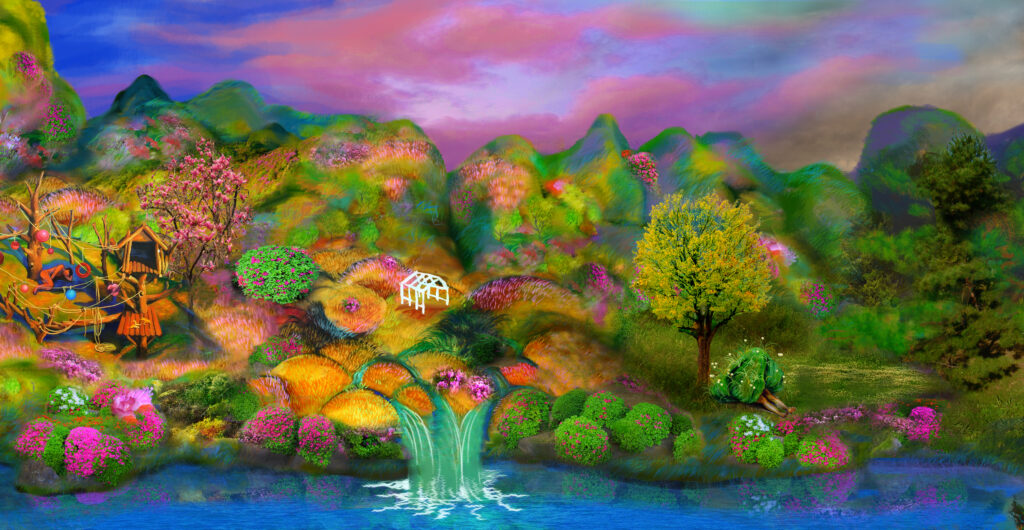
Friday 15 March – Sunday 31 March
Naked Island
Heejeong Jeong
2015 / South Korea
Salle Gilbert-Gaillard
Opening hours :
Tuesday to Saturday, 1pm to 7pm
Sunday from 2pm to 6pm
This post is also available in: Français (French)

Friday 15 March – Sunday 31 March
Opening hours :
Tuesday to Saturday, 1pm to 7pm
Sunday from 2pm to 6pm
Heejeong Jeong’s Naked Island is a panoramic animated video that reinterprets contemporary landscapes through the lens of Sansuwha (Shan Shui, landscape painting). The video work presents a dynamic landscape that undergoes gradual transformations as the passage of time and the shifting seasons—spring, summer, fall, and winter—interact. What makes this portrayal intriguing is not solely the cycle of the sun rising and setting, flowers blossoming and withering, or leaves flourishing and falling. Rather, it is the subtle yet significant alterations that unfold: a traditional pavilion in daylight gives way to a contemporary gazebo at night, an apartment complex emerges within the once dense forest, a serene cemetery transforms into a desolate hill, and a playground where children once frolicked vanishes without a trace. Indeed, populated with diverse imagery from various locations and scenes, the landscape of Naked Island evokes an unsettling and eerie atmosphere, leaving viewers with a sense of discomfort and unease. This juxtaposition of familiar and unfamiliar elements contributes to the creation of a surreal and enigmatic experience, captivating the viewer’s imagination and inviting contemplation on themes of impermanence, transformation, and the unsettling nature of change.
Naked Island serves as a cinematic metaphor for the disjointed and fragmented development of Korea, seamlessly connecting disparate scenes like frames in a movie reel. The island, in its perpetual cycle of transformation, mirrors the rapid evolution of the Korean landscape. Much like a model swiftly changing outfits backstage, new buildings emerge overnight while longstanding shops vanish without a trace. Through the relentless pace of development and redevelopment, the landscape bears witness to a multitude of events and upheavals, shaping its current form through countless days and nights, changing seasons, and enduring waves of change. Amidst this whirlwind of progress, nature stands as a resilient anchor, steadfastly enduring the onslaught of development. The mountains and waters of Korea, despite the ceaseless construction and reconstruction, remain enduring symbols of resilience and continuity.
– Ho Kyung MOON, Independent Curator, Director of PLUSMOON
Heejeong Jeong is very interested in the power of landscapes that are difficult to capture through the logic of reason, through photography and video. The artist uses unique colors and screen compositions to visualize symbols that are not easily read, revealing the dangers or fascinating moments embedded in ordinary daily life. At the 2017 Seoul International New Media Festival, she won the Audience Award for “The Red Room.”

Credits :
Heejeong JEONG (South Korea)
Video installation, 8’ 55’’, 2015
Music: Pascal Plantinga

Interview by Fanny Bauguil, VIDEOFORMES relay teacher
“Naked Island” is a story about landscape. The landscape of Korea from more than a century ago is summarized in the landscape paintings of the Joseon Dynasty. It was closer to a utopia than an actual landscape. “Naked Island” is a panoramic animation that overlaps today’s landscapes based on the format of landscape painting. Korea’s four seasons, night and day unfold.
Landscape is created by humans, not nature. It includes a perspective on the world. Korea’s modern era changed rapidly with colonial rule by Japan and the Korean War. If a place that does not exist but is dreamed of is called utopia, then “Naked Island” is an allegory about a landscape that really exists, but rationality cannot see and passes by.
In 2015, “Naked Island” was screened for the first time at the Gyeonggi Museum of Art using photos, paintings, and panoramic videos under the theme of landscape. Since then, <Naked Island> has been the most widely presented of my works. “Naked Island” was the beginning of panoramic work.
It originated from the scroll-type landscape painting that was popular during the Joseon Dynasty. It is also called roll paper, and refers to an item made by stretching paper or cloth and inserting a shaft at the end so that it can be rolled up.
Unlike Western landscape paintings, landscape paintings during the Joseon Dynasty were not meant to be hung on the wall to be admired, but rather kept in a drawer and opened whenever one wanted. I imagined the feeling of taking out a scenery stored in a drawer 100 years ago, and created a scenery that flows in one direction, like an unfolding scroll.
“Naked Island” is based on the original painting. I converted the independent pictures, like puzzles, into digital format and stitched them together like a photo collage. And I made it into a video moving in one direction with some animation. It can be said to be a mixture of painting and photography. As mentioned earlier, it was inspired by the scroll format, one of the forms of landscape painting during the Joseon Dynasty. When you unfold the paper, you stay in the fantasy of the image, and like rolling a scroll and putting it in a drawer, when you turn off the power, the light disappears and it remains as a USB stick and puts it in the drawer.
The video is one long picture, and when it was first produced, it was imagined as a 360-degree circular screen with no beginning or end. Therefore, the resolution varies depending on the output device. Since it can be modified depending on the length of the output screen, the displayed resolution also varies depending on the exhibition space.
Panorama; Wall to wall; Amphitheater
Having grown up in Korea, I remember the 90s and 2000s completely differently. In the early 2000s, optical communication was installed throughout the country in a short period of time, and personal computers were distributed to every home. In short, it was a digital boom. While I was drawing, I was unconsciously sitting in front of the computer and fiddling with Photoshop. It was an adaptation to the changed environment rather than a conscious one.
Digital work was much easier and less burdensome than painting work, which was subject to many limitations in physical space. Whether one can make a living as a work of art is another question. This is because not everyone who works digitally becomes rich with digital coins.